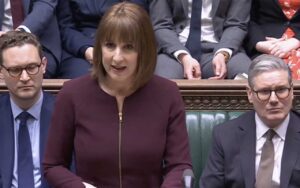
The UK economy shrank for the second consecutive month in May, in an early setback for new Chancellor Rachel Reeves and a sign that the fragile recovery may be stalling.
According to figures released this morning by the Office for National Statistics (ONS), GDP contracted by 0.1% in May, falling short of analysts’ expectations for a modest rebound. This follows a sharper 0.3% drop in April and marks the second month of decline after a brief bounce of 0.4% in March.
The ONS said the decline in May was driven primarily by a 0.9% fall in industrial production and a 0.6% drop in construction output, although the dominant services sector managed slight growth of 0.1%.
The ONS noted:
Services output grew by 0.1% in May, following a 0.3% decline in April.
Production output – covering manufacturing and energy – dropped 0.9%, after falling 0.6% in April.
Construction output declined 0.6% in May, reversing gains made in April.
While all three sectors showed growth over the three months to May – led by a 1.2% rise in construction – the month-on-month picture paints a more concerning image of an economy struggling to build momentum.
The data comes just a week after Rachel Reeves pledged to deliver “stability and growth” through her new fiscal rules and a pro-business agenda. But with economic activity faltering, the Chancellor faces growing pressure to set out a clear strategy to boost investment and avoid further slowdowns.
Ben Jones, lead economist at the Confederation of British Industry (CBI), said today’s data highlights the risks still facing UK businesses “Flatlining growth in May underscores the ongoing pressures on the economy, with manufacturing and retail continuing to struggle. Persistent trade uncertainty, a cooling labour market and slowing income growth all point to a sluggish recovery.”
“With the Autumn Budget on the horizon, the Chancellor must reassure firms that there will be no new taxes on business—and instead focus on dismantling barriers to growth.”
Jones added that a “collaborative partnership between business and government” would be crucial to sustaining any meaningful recovery.
May’s contraction also reflects broader global headwinds. The IMF has downgraded its forecast for global growth, citing geopolitical risks and weaker trade flows, while central banks remain cautious about cutting interest rates too quickly.
UK inflation is now back at the Bank of England’s 2% target, but borrowing costs remain elevated and have weighed on household demand and business investment. Analysts warn that without targeted support, the economy may struggle to generate the kind of momentum needed to lift living standards and unlock productivity gains.
Economists say the risk of stagnation over the summer remains high, particularly if global demand weakens further or consumer confidence slips. However, some note that the longer-term outlook could improve if inflation continues to ease and interest rate cuts materialise later this year.
For now, though, the warning signs are clear: while services may be ticking over, the UK’s industrial and construction base is still under strain. And with the new government under increasing pressure to deliver on its growth agenda, today’s figures may prove a critical early test of its economic credibility.
Read more:
UK economy shrinks again in May, fuelling fears of faltering recovery




